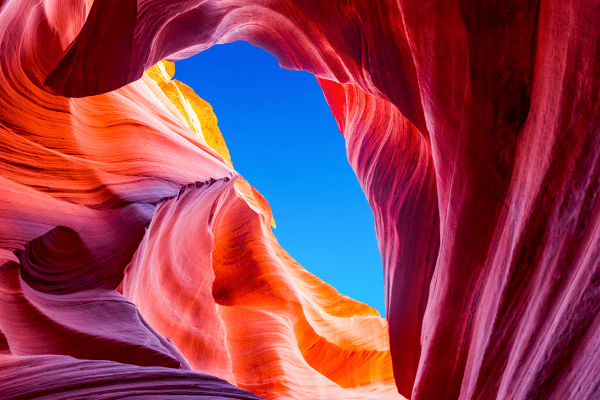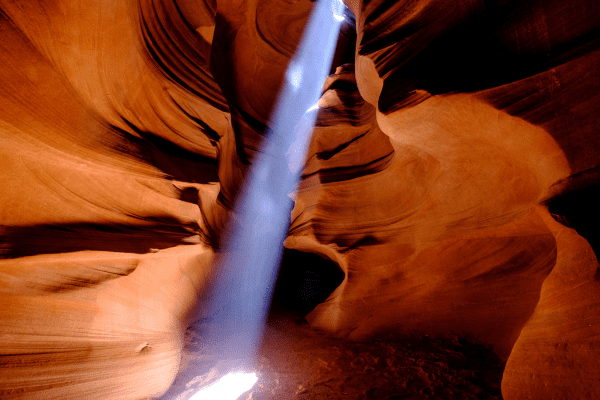

Located in the heart of the American Southwest, Antelope Canyon is a testament to the incredible power of nature's art. Grab your camera, put on your explorer hat, and get ready for an adventure that will leave an indelible impression!
As the sun's rays penetrate the narrow cracks and crevices, they paint the canyon with a kaleidoscope of colors. You'll be mesmerized by the vibrant reds, oranges, and purples that illuminate every nook and cranny, creating a visual spectacle that is simply breathtaking. But before we dive into the magic, here are some useful facts about Antelope Canyon:

To explore Antelope Canyon is to enter another world where time stands still, and nature's art takes center stage. As you venture through the narrow passages and winding corridors, you'll be amazed by the ever-changing colors and shapes.
As a protected area, access to Antelope Canyon is by guided tour only. Knowledgeable guides will lead you safely through the canyon and share fascinating stories about its formation and cultural significance.
Book your flights and be sure not to miss some of the attractions during your visit:
Upper Antelope Canyon is the most visited part of Antelope Canyon and offers visitors spectacular views of the steep rock walls created by the erosion of water and wind. Upper Antelope Canyon is also famous for its sunbeams that appear in summer when sunlight shines through the canyon's narrow opening.
Lower Antelope Canyon is less crowded than Upper Antelope Canyon and offers visitors the same breathtaking views of the rock walls and rays. Unlike Upper Antelope Canyon, Lower Antelope Canyon is narrower and steeper, making it an exciting adventure.
Antelope Canyon's sunbeams are one of the main attractions and most spectacular sights in the area. They appear in the summer when sunlight shines through the narrow opening of the canyon, creating a spectacular light show. The rays move throughout the day, changing the appearance of the canyon.
Part of the larger Antelope Canyon system, Rattlesnake Canyon is known for the impressive rock formations and slot canyons that dot its landscape. This canyon is also home to Owl Canyon, known for its resident eagle owls. Compared to Antelope Canyon, Rattlesnake Canyon is less crowded and offers better photo opportunities.
Imagine standing on the edge of a cliff, surrounded by the fiery red rocks of the Arizona desert. Looking down, you see the mighty Colorado River winding its way through the landscape in the shape of a horseshoe. This is the incredible Horseshoe Bend - a natural wonder that will blow your mind!
The hike to the overlook is a breeze for adventurers of all skill levels, and the views are breathtaking. The sharp contrast between the bright blue of the river and the rich red of the surrounding rocks makes for a mesmerizing spectacle.
Lake Powell is a fantastic destination near Antelope Canyons. This beautiful lake, created by Glen Canyon Dam, offers a variety of recreational activities, including swimming, boating, fishing, and kayaking.
Many hiking trails will take you on an unforgettable journey through the area's high cliffs and colorful rock formations. Rent a boat and explore the hidden coves and secret corners of the lake. If you are looking for something more adventurous, try kayaking.
Paddle through narrow gorges, marvel at the fascinating geological formations, and be awed by the beauty of this natural wonder.
Just a few miles from Antelope Canyon is the Navajo National Monument. The monument is home to some of the best preserved ancient Pueblo and cliff dwellings in the United States. It is a great place to learn about Navajo history and culture.

Antelope Canyon was formed millions of years ago by water and wind erosion. There is evidence that the canyon was inhabited by Native Americans as early as 1200 AD. Originally, the canyon was known to the Navajo as "Tse' bighanilini," which means "the place where the water flows through the rocks. In the mid-1800s, a group of Mormon settlers named it "Cataract Canyon," probably because it resembles a waterfall.
In 1997, a devastating flash flood occurred in the canyon, killing 11 people. This tragedy drew attention to the dangers of flash floods and prompted the Navajo Parks and Recreation Department to establish flash flood warnings for the area.
In 1999, the Navajo Parks and Recreation Department was formed to take over the management of Antelope Canyon. They began implementing rules and regulations to protect the canyon and its visitors.
The most popular way to get to Antelope Canyon is by car. The drive from Flagstaff, Arizona, takes about 3.5 hours. From Las Vegas, Nevada, the drive takes about 4.5 hours. From Phoenix, Arizona, the drive takes about 5 hours. If driving to Antelope Canyon, check in advance for road closures or other obstacles.
Several tour companies provide transportation to and from Antelope Canyon. Tour companies are often the most convenient and stress-free way to get to the canyon, as they usually include admission and other extras. If you're interested in taking a tour, research the company and read reviews before booking.
For those looking for a cheaper alternative, some shuttle buses provide transportation to and from Antelope Canyon. The buses will pick you up and drop you off in Flagstaff, Las Vegas, or Phoenix. Check the schedule and book in advance to secure a spot on the shuttle.
If you visit the Canyon in the summer, wear light, loose clothing and bring plenty of water. It can get very hot in the canyon, so it is important to stay hydrated and protected from the sun. It is also important to wear appropriate footwear, as the terrain can be rocky and uneven.
You are about to experience one of the most beautiful and awe-inspiring places in the world. However, Antelope Canyon can be very crowded at peak times. If possible, visit in the early morning or late afternoon when it's less crowded. You'll have more time to explore the canyon and take pictures without being distracted by other tourists.
You should also bring your own food. Antelope Canyon is a remote area with no facilities or restaurants. Bring plenty of water, snacks, and sunscreen to stay comfortable during your visit.
The canyon is sandstone and can be slippery in places. Wear sturdy shoes with good traction, so you don't slip. Also, it can be very windy in the canyon, so a light jacket or windbreaker is recommended.
Win one of 55,000 Green Cards in the official Green Card Lottery of the US authorities!